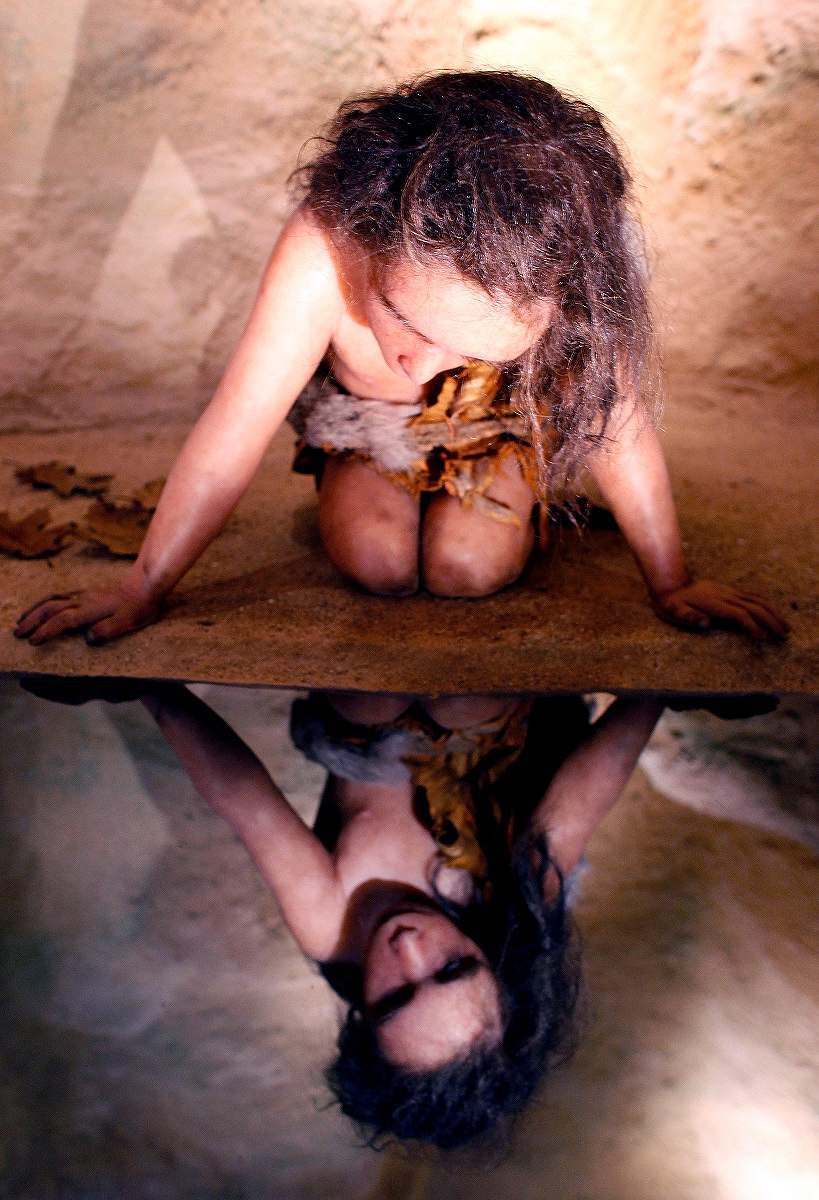
A realistic figure of a Neanderthal child looking at a reflection in the water is seen in the new Neanderthal Museum, in the northern Croatian town of Krapina, in February 2010.
13:58 JST, July 5, 2024
Living among a small band of Neanderthals in what is now eastern Spain was a child, perhaps 6 years old, with Down syndrome, as shown in a remarkable fossil preserving traits in the inner ear anatomy indicative of this serious genetic condition.
This fossil, unearthed at the Cova Negra archeological site in the province of Valencia near the city of Xativa, not only represents the earliest-known evidence of Down syndrome but, according to scientists, hints at compassionate caregiving in these extinct archaic humans — close cousins to our own species.
While the researchers cannot be certain of whether this was a girl or boy, they nicknamed the Neanderthal child “Tina.”
The fossil, preserving the complete inner ear anatomy, was excavated in 1989 but its significance was not recognized until recently. It is a fragment of one of the two temporal bones — the right one — that help form the sides and base of the skull, protecting the brain and surrounding the ear canal.
Tina’s combination of inner ear abnormalities is known only in people with Down syndrome.
“The pathology which this individual suffered resulted in highly disabling symptoms, including, at the very least, complete deafness, severe vertigo attacks and an inability to maintain balance,” said paleoanthropologist Mercedes Conde-Valverde of the University of Alcala in Spain, lead author of the study published in the journal Science Advances.
“Given these symptoms, it is highly unlikely that the mother alone could have provided all the necessary care while also attending to her own needs. Therefore, for Tina to have survived for at least six years, the group must have continuously assisted the mother, either by relieving her in the care of the child, helping with her daily tasks or both,” Conde-Valverde added.
Among other pathologies, there were abnormalities in the semicircular canals — three small tubes that govern balance and sense head position — and a reduction in the size of the cochlea, the part of the inner ear involved in hearing.
The fossil’s precise age has not been determined, but Conde-Valverde noted that the presence of Neanderthals at the Cova Negra site has been dated to between 273,000 and 146,000 years ago.
Neanderthals, formally called Homo neanderthalensis, were more robustly built than Homo sapiens and had larger brows. They lived from around 430,000 years ago to roughly 40,000 years ago. Previous research has shown that Neanderthals were intelligent, creating art and using complex group hunting methods, pigments probably for body painting, symbolic objects and perhaps spoken language.
They disappeared relatively soon after our species spread into their territory.
Previous evidence of Neanderthals caring for their sick and injured prompted a debate over whether this was motivated merely by expectations of reciprocal behavior or by genuine compassion.
“For decades, it has been known that Neanderthals cared for and looked after their vulnerable companions. However, all known cases of care involved adult individuals, leading some scientists to believe that this behavior was not genuine altruism but merely an exchange of assistance between equals: ‘Today for you, tomorrow for me,’” Conde-Valverde said.
“What was not known until now was a case of an individual who had received extra-maternal care from birth, even though the individual could not reciprocate. The discovery of the Cova Negra fossil supports the existence of true altruism among Neanderthals,” Conde-Valverde added.
Archeological evidence at Cova Negra indicates the site was occupied for short periods at a time by small groups of Neanderthals, hunter-gatherers who roamed the landscape in search of food and other resources. Tina’s age at death, based on the maturation state of certain inner ear structures, showed unusual longevity for a child in such circumstances with a condition known for intellectual disability and developmental delays.
“The survival of this child, beyond the period of breastfeeding, implies group caregiving, probably more extended than parental caregiving, typical of a highly collaborative social context among the members of the group. Otherwise, it is very difficult to explain the survival of this individual up to the age of 6 years,” said study coauthor Valentin Villaverde, a University of Valencia emeritus professor of prehistory.
“The discovery of Tina,” Conde-Valverde said, “represents the oldest known case of Down syndrome and demonstrates that the diversity observed in modern humans was already present in prehistoric times. This finding ensures that the story of human evolution includes us all.”
"Science & Nature" POPULAR ARTICLE
-

Genome Study Reveals Milestone in History of Cat Domestication
-

Big Leap in Quest to Get to Bottom of Climate Ice Mystery
-

Security Camera Footage Vulnerable to Outside Access; Investigation Finds 3,000 Pieces Exposed Online
-

Paws on Parade: Nairobi’s Dogs Dazzle at ‘Pawchella’
-

Japan Set to Participate in EU’s R&D Framework, Aims to Boost Cooperation in Tech, Energy
JN ACCESS RANKING
-

Keidanren Chairman Yoshinobu Tsutsui Visits Kashiwazaki-Kariwa Nuclear Power Plant; Inspects New Emergency Safety System
-

Tokyo Economic Security Forum to Hold Inaugural Meeting Amid Tense Global Environment
-

Imports of Rare Earths from China Facing Delays, May Be Caused by Deterioration of Japan-China Relations
-

University of Tokyo Professor Discusses Japanese Economic Security in Interview Ahead of Forum
-

Japan Pulls out of Vietnam Nuclear Project, Complicating Hanoi’s Power Plans






















